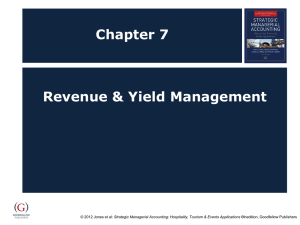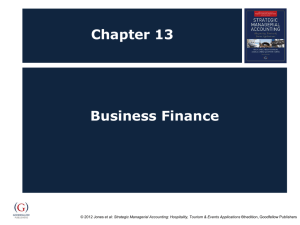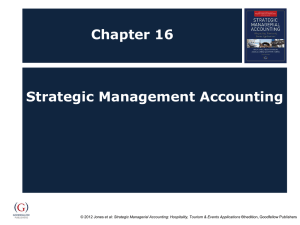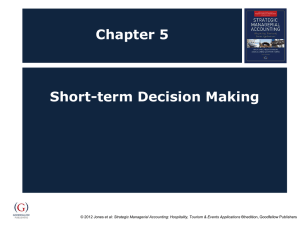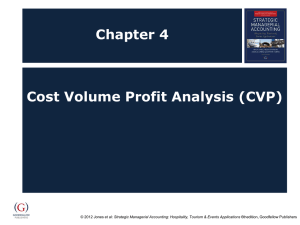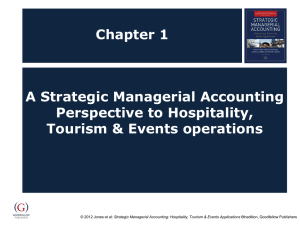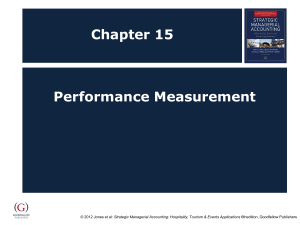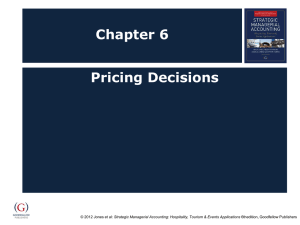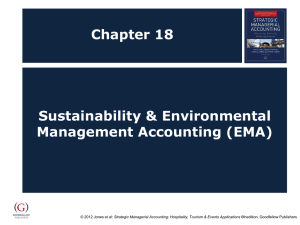Chapter 2 - Goodfellow Publishers
advertisement
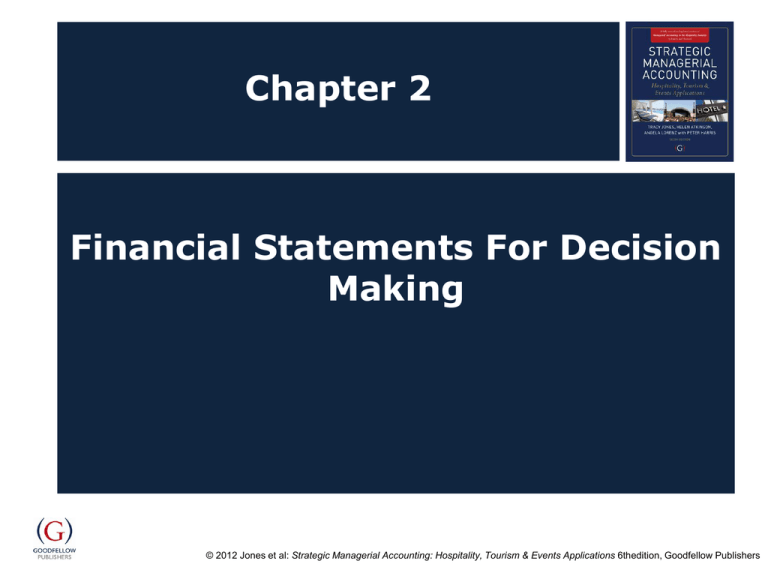
Chapter 2 Financial Statements For Decision Making © 2012 Jones et al: Strategic Managerial Accounting: Hospitality, Tourism & Events Applications 6thedition, Goodfellow Publishers Objectives After studying this topic you should be able to: Develop knowledge and understanding of a variety of accounting statements; Critically evaluate the usefulness of such information to managers, and other statement users; Develop knowledge of alternative accounting terminology used within financial reports; and Develop a working knowledge of the concepts of profit and cash in the business context. © 2012 Jones et al: Strategic Managerial Accounting: Hospitality, Tourism & Events Applications 6thedition, Goodfellow Publishers The difference between profit & cash Profit = the surplus of value between sales revenue and associated costs for the same period Sales Revenue – Costs = Profit © 2012 Jones et al: Strategic Managerial Accounting: Hospitality, Tourism & Events Applications 6thedition, Goodfellow Publishers Example: difference between cash and profit Cultural Events is a small local events company, its operating information for one month, April is: Sales for the period are £40,000, which includes £10,000 invoiced and yet to be paid by the customer; Cost of sales, £12,000, which includes £6,000 still to be paid to the supplier; Expenses for the month are £20,000, but this includes £4,000 paid previously and £6,000 not to be paid until the next month; At the start of the month the bank balance (cash) was £5,000 A cash payment of £15,000 is paid in April related to last month’s expenses. © 2012 Jones et al: Strategic Managerial Accounting: Hospitality, Tourism & Events Applications 6thedition, Goodfellow Publishers Solution Cultural Events Profit Cash Opening cash Sales Revenue £40,000 - Cost of sales £12,000 £35,000 = Gross Profit £28,000 - Expenses for March £15,000 - Expenses £20,000 - Expenses for April £10,000 Profit + cash from sales £5,000 £8,000 Closing cash £30,000 £10,000 © 2012 Jones et al: Strategic Managerial Accounting: Hospitality, Tourism & Events Applications 6thedition, Goodfellow Publishers External financial reporting Standardisation over time has led to International Financial Reporting Standards (IFRS) being developed which are being adopted in a number of countries. © 2012 Jones et al: Strategic Managerial Accounting: Hospitality, Tourism & Events Applications 6thedition, Goodfellow Publishers The international convergence of accounting standards Australia, European Union countries (incl. France, Germany, Italy, United Kingdom - UK), South Africa, Turkey Argentina, Mexico, Russia, Use of IFRS since 2005, some countries for listed companies only Brazil 2008 or 2010, depending on type of company Canada 2011, plus allowed for not-for-profit organisation China Broad convergence with national standards India, Indonesia Planned convergence Japan Allowed for some international companies since 2010, further adoption under consideration Republic of Korea 2011 Saudi Arabia Required in banking sector, under consideration more generally United States (USA) Allowed for foreign company users since 2007, aiming for substantial convergence 2012 (data from IFRS 2012) © 2012 Jones et al: Strategic Managerial Accounting: Hospitality, Tourism & Events Applications 6thedition, Goodfellow Publishers Statement of Comprehensive Income Statement of Income for the year ended 31st December XXX2 Revenue Cost of sales Gross Profit Other income Distribution costs Administrative expenses Other expenses Finance costs Profit before tax Income tax expense Profit for the year 31st December XXX2 6,900 (710) 6,190 700 (80) 31st December XXX1 7,400 (680) 6,720 670 (72) (3450) (690) (40) 2,630 (790) 1,840 (3,708) (740) (60) 2,810 (843) 1,967 (Note: data for format illustrative purposes only) © 2012 Jones et al: Strategic Managerial Accounting: Hospitality, Tourism & Events Applications 6thedition, Goodfellow Publishers Statement of Financial Position terms (1) Accounting Term Alternative Term Statement of Financial Balance Sheet Position Description A statement that shows what a company owns and owes at a given point in time Assets Something the company owns, or has use of Non-current assets Fixed assets Current assets Inventories Stock Trade receivables Debtors & Prepayments Assets that usually have a useful life for the company longer than 12 months e.g. Owned property, machinery, equipment Assets that are short term, usually have a useful life for the company shorter than 12 months e.g. Cash, Inventory, trade receivables The value of the stock of goods for resale e.g. Stock of food, drink, merchandising, shop stock Money outstanding from sales, customers to pay in the future & things paid for but still to ‘use’ e.g. Customers with credit terms still to pay. A prepayment could be paying a year’s insurance at the start of the year © 2012 Jones et al: Strategic Managerial Accounting: Hospitality, Tourism & Events Applications 6thedition, Goodfellow Publishers Statement of Financial Position terms (2) Accounting Term Alternative Term Equity Shareholders’ funds The owners’ value in the business e.g. Value of shares, retained profits, reserves Liabilities Non-current liabilities Current liabilities Trade payables Description An obligation to be met in the future Long-term liabilities Liabilities, usually over 1 year e.g. Bank loans Short-term liabilities, to be met within 12 months Creditors & Accruals The amount you owe to your suppliers e.g. Amounts you owe for stocks already purchased, but yet to pay. Electricity that you are invoiced for after consumption would be an accrual © 2012 Jones et al: Strategic Managerial Accounting: Hospitality, Tourism & Events Applications 6thedition, Goodfellow Publishers Statement of Financial Position (1) Statement of Financial Position as at 31st December XXX2 31st December XXX2 31st December XXX1 ASSETS Non-current assets Property, plant and equipment 750 740 Intangible assets 100 100 850 840 Current assets Inventories 85 80 Trade receivables 140 160 Cash and cash equivalents 300 270 525 510 Total assets 1375 1350 © 2012 Jones et al: Strategic Managerial Accounting: Hospitality, Tourism & Events Applications 6thedition, Goodfellow Publishers Statement of Financial Position (2) Statement of Financial Position as at 31st December XXX2 31st December XXX2 EQUITIY AND LIABILITIES Equity attributable to owners Share capital 850 Retained earnings 180 Total equity 1030 Non-current liabilities Long-term borrowings Deferred tax Total non-current liabilities Current liabilities Trade payables Short-term borrowings Current tax payable Total current liabilities Total liabilities Total equity and liabilities 31st December XXX1 700 140 840 150 10 160 244 30 274 150 10 25 185 345 1375 194 12 30 236 510 1350 © 2012 Jones et al: Strategic Managerial Accounting: Hospitality, Tourism & Events Applications 6thedition, Goodfellow Publishers Statement of Cash flows Direct Method Cash receipts from customers xxx Cash paid to suppliers xxx Cash paid to employees xxx Cash paid for other operating expenses Interest paid xxx Income taxes paid xxx Net cash from operating activities xxx xxx © 2012 Jones et al: Strategic Managerial Accounting: Hospitality, Tourism & Events Applications 6thedition, Goodfellow Publishers Statement of Cash flows Indirect Method Profit before interest and income taxes xxx Add back depreciation xxx Add back amortisation of goodwill xxx Increase in receivables xxx Decrease in inventories xxx Increase in trade payables xxx Interest expense xxx Less Interest accrued but not yet paid xxx Interest paid xxx Income taxes paid xxx Net cash from operating activities xxx © 2012 Jones et al: Strategic Managerial Accounting: Hospitality, Tourism & Events Applications 6thedition, Goodfellow Publishers Uniform System of Accounting for the Lodging Industry (USALI) Hospitality specific reporting framework Developed in the 1920’s Responsibility accounting format Provides a complete management accounting reporting system Allows external benchmarking Used in industry-wide studies Useful in management contract operations © 2012 Jones et al: Strategic Managerial Accounting: Hospitality, Tourism & Events Applications 6thedition, Goodfellow Publishers Example: USALI Department Statement © 2012 Jones et al: Strategic Managerial Accounting: Hospitality, Tourism & Events Applications 6thedition, Goodfellow Publishers Example: USALI Summary Statement of Income * Income - in this American terminology ‘income’ relates to what in the UK would be termed ‘Profit’ © 2012 Jones et al: Strategic Managerial Accounting: Hospitality, Tourism & Events Applications 6thedition, Goodfellow Publishers Example Room Statement © 2012 Jones et al: Strategic Managerial Accounting: Hospitality, Tourism & Events Applications 6thedition, Goodfellow Publishers Summary Cash and profit refer to different elements of the accounts and should never be used interchangeably, they are different. A number of different ‘GAAPs’ exist, international GAAP, using IFRS are used more widely than other ‘national’ county specific GAAPs. External reporting statements can be utilised internally for management accounting analysis purposes, but are too general and far reaching for operational decision making. USALI is well utilised as a reporting framework within hospitality and is one of the oldest sector specific internal reporting frameworks in the world. USALI serves many purposes for internal reporting and external benchmarking for decision making. © 2012 Jones et al: Strategic Managerial Accounting: Hospitality, Tourism & Events Applications 6thedition, Goodfellow Publishers
